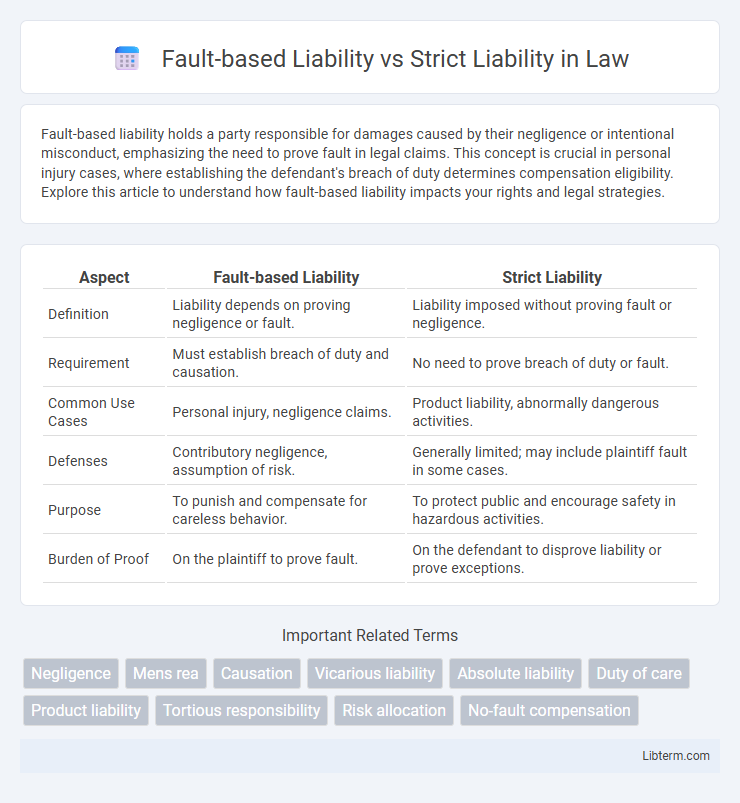Fault-based liability holds a party responsible for damages caused by their negligence or intentional misconduct, emphasizing the need to prove fault in legal claims. This concept is crucial in personal injury cases, where establishing the defendant's breach of duty determines compensation eligibility. Explore this article to understand how fault-based liability impacts your rights and legal strategies.
Table of Comparison
| Aspect | Fault-based Liability | Strict Liability |
|---|---|---|
| Definition | Liability depends on proving negligence or fault. | Liability imposed without proving fault or negligence. |
| Requirement | Must establish breach of duty and causation. | No need to prove breach of duty or fault. |
| Common Use Cases | Personal injury, negligence claims. | Product liability, abnormally dangerous activities. |
| Defenses | Contributory negligence, assumption of risk. | Generally limited; may include plaintiff fault in some cases. |
| Purpose | To punish and compensate for careless behavior. | To protect public and encourage safety in hazardous activities. |
| Burden of Proof | On the plaintiff to prove fault. | On the defendant to disprove liability or prove exceptions. |
Introduction to Liability in Law
Liability in law establishes responsibility for harm or damages caused by one's actions or omissions. Fault-based liability requires proving negligence, intent, or fault to hold a party accountable, emphasizing the defendant's state of mind. Strict liability imposes responsibility regardless of fault, often applied in inherently hazardous activities or product liability cases to ensure victim compensation.
Defining Fault-based Liability
Fault-based liability requires proving negligence or intentional wrongdoing by the defendant, establishing a breach of duty that caused harm to the plaintiff. This accountability depends on demonstrating fault through elements such as duty, breach, causation, and damages, commonly applied in tort law. It contrasts with strict liability, where liability is imposed regardless of fault or intent.
Defining Strict Liability
Strict liability holds a party legally responsible for damages regardless of fault or intent, emphasizing product defects or inherently dangerous activities where harm is foreseeable. Unlike fault-based liability, which requires proving negligence or intent, strict liability imposes responsibility automatically upon proof that the activity or product caused injury. This doctrine primarily applies in product liability cases, abnormally dangerous operations, and certain statutory violations, streamlining the plaintiff's burden of proof.
Key Differences Between Fault-based and Strict Liability
Fault-based liability requires proving negligence or intent to establish legal responsibility, emphasizing the defendant's conduct and mental state. Strict liability imposes responsibility regardless of fault, primarily applied in inherently dangerous activities or product defects, focusing on the occurrence of harm itself. The key difference lies in the necessity of proving fault in fault-based claims versus liability assigned regardless of fault in strict liability cases.
Legal Principles Underlying Each Liability Type
Fault-based liability centers on the principle that a defendant is accountable only when negligence or intentional wrongdoing is proven, requiring clear evidence of breach of duty and causation. Strict liability imposes responsibility irrespective of fault, primarily applicable in inherently hazardous activities or defective product cases, emphasizing risk allocation over fault. These legal principles balance the need to incentivize careful behavior against ensuring victim compensation without complex proof of negligence.
Common Examples of Fault-based Liability Cases
Fault-based liability cases commonly include car accidents where negligence like distracted driving causes harm, medical malpractice involving errors from healthcare providers, and slip-and-fall incidents due to property owners' failure to maintain safe conditions. These cases require proving that the defendant breached a duty of care, directly resulting in the plaintiff's injury or damages. Courts analyze evidence such as witness testimony, expert opinions, and documented breaches to establish fault and liability.
Common Examples of Strict Liability Cases
Strict liability cases frequently involve inherently dangerous activities such as using explosives, owning wild animals, or manufacturing defective products that cause harm regardless of negligence. For example, product liability claims often hold manufacturers strictly liable when defective goods injure consumers, without requiring proof of fault or intent. Legal systems impose strict liability in these scenarios to ensure victim compensation and incentivize maximum safety precautions.
Advantages and Disadvantages of Fault-based Liability
Fault-based liability emphasizes negligence or intent, promoting personal accountability and deterring careless behavior by requiring proof of fault before awarding damages. Its advantage lies in fairness, as it holds only responsible parties liable, but the disadvantage includes complex, costly litigation and difficulties in proving fault, potentially delaying compensation for victims. This system may burden plaintiffs with substantial evidence requirements, limiting access to justice for those unable to demonstrate clear negligence.
Advantages and Disadvantages of Strict Liability
Strict liability simplifies legal processes by holding defendants responsible for damages regardless of fault, enhancing consumer protection and streamlining claim resolutions. This liability type can encourage companies to prioritize safety and implement more rigorous risk management strategies. However, it may lead to unfair outcomes for defendants who are not negligent and can increase business costs due to higher insurance premiums and compliance expenses.
Conclusion: Choosing Between Fault-based and Strict Liability
Choosing between fault-based liability and strict liability depends on the nature of the legal issue and policy objectives. Fault-based liability emphasizes proving negligence or intent, which is suitable for complex cases requiring detailed fault analysis. Strict liability simplifies plaintiff claims by removing the need to prove fault, making it ideal for inherently dangerous activities or products with high risk.
Fault-based Liability Infographic

 libterm.com
libterm.com